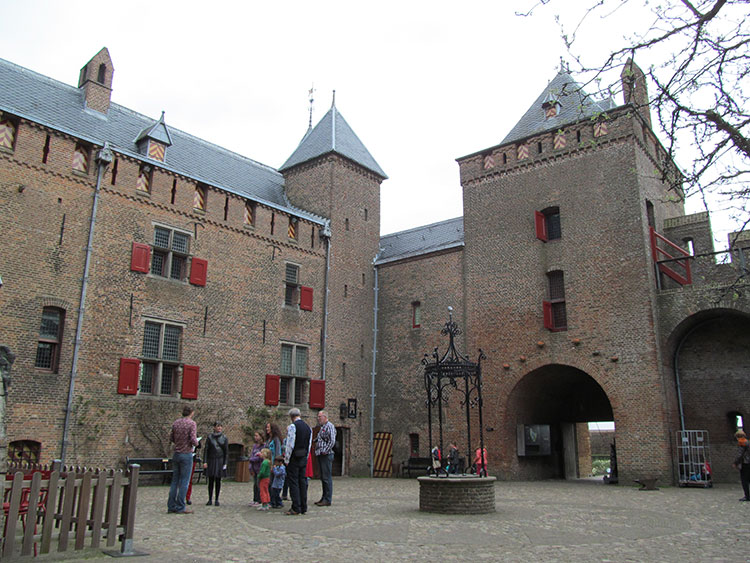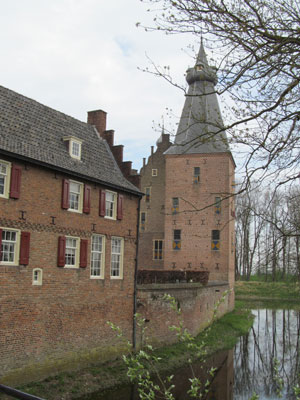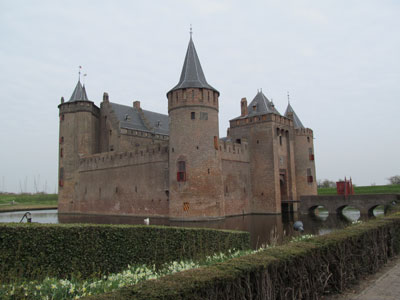A day in the Dutch countryside
This item appears on page 61 of the September 2013 issue.
(Part 2 of 2 on the Netherlands)
In last month’s issue I wrote about the hofjes of Amsterdam, places of beauty and serenity scattered throughout the city. These old courtyards surrounded by equally old houses provided my husband and me with the quiet we needed to escape some of the hoopla surrounding the April 30, 2013, abdication of the Dutch Queen Beatrix and the accession to the throne of her eldest son, Willem Alexander.
Just as the hofjes provided us with one escape, so did a day in the countryside visiting two picturesque and historic Dutch castles.
A quick computer check surprised me with the fact that there are more than 100 castles still left in the Netherlands that can be visited. The two we visited were Muiden Castle and Doorwerth Castle.
Similarities and differences
In comparing these two castles, I’ll first list their similarities: Muiden Castle and Doorwerth Castle are both [1] over 700 years old, [2] extremely picturesque and [3] relatively close to Amsterdam. Muiden, at 11 miles away, is the closer of the two, and Doorwerth is 63 miles from the city.
The differences — Muiden has been designated a UNESCO World Heritage Site. Muiden has a past associated with two major Dutch figures: Count Floris V (13th century) and P.C. Hooft, often called the Dutch Shakespeare (17th century). And Muiden is close to Amsterdam. All three factors make it one of the most visited castles in the Netherlands.
Doorwerth, farther from Amsterdam, is a castle whose ownership, beginning with the Van Dorenweerd family in the late 13th century, has bounced around among counts, barons and lords for more than six centuries until the castle was destroyed during World War II. (It’s been restored since.) It’s a quiet place to visit.
Muiden Castle
The earliest Muiden Castle was built on the Vecht River in 1285 by Count Floris V to collect tolls from trading ships. This created conflict with Floris’ neighbor farther along the river, Willem van Mechelen, the prince-bishop of Utrecht. In 1296, Floris was killed by his own nobles and his castle destroyed by van Mechelen.
The castle visitors see today is the one built by Duke Albrecht I, Duke of Bavaria, around 1370. It’s a square stone castle with four round corner turrets each capped with what resembles a witch’s hat. There is a rampart wall along two sides, and the entire castle is surrounded by a moat.
During the 17th century, the Dutch Golden Age, P.C. Hooft, one of the Netherlands’ most famous writers and poets, was appointed bailiff of Muiden and lived in the castle for 38 years. The castle is furnished to look as it did in his day.
Today visitors can follow two routes on their own through the castle: the Knight’s Route and the Tower Route. There is also a guided tour to see the rooms where P.C. Hooft lived. Visitors should not miss a walk through the Renaissance gardens just outside the moat.
From April to October, Muiden Castle is open 10 to 5 Monday to Saturday and 12 to 5 Sunday. From November to March it’s open only on weekends from 1 to 4. The admission charge is €12.50 (near $16). The Museum Card can be used there.
Doorwerth Castle
Muiden is a nobleman’s castle. Doorwerth is a gentleman’s manor house although as imposing as Muiden. The first wooden castle at Doorwerth, built around 1260, was besieged and burnt. It was rebuilt soon afterward in stone and was a relatively simple structure consisting of a 2-story keep surrounded by a moat fed by the Rhine River.
This early castle was enlarged by successive owners, reaching its largest extent in the mid 16th century under the 15th Lord of Dorenweerd. What followed in successive centuries were periods of occupation followed by neglect, culminating in the castle’s destruction in 1944. Post-war restoration took 37 years.
Visitors can guide themselves through the castle, passing through seven centuries of its construction and history.
The Great Hall belongs to the earliest days of the castle’s history. In fact, the original 13th-century castle probably consisted only of this rectangular hall, which would have been where the lord of the manor and his entourage lived. In times of danger, it would become their fortified refuge, as well.
Growth of the castle
Around 1400 an extension was added, doubling the size of the castle. This extension was made into a bedroom for the family and household and a dining room, both now furnished as they might have been in the 1600s.
The hall that is now the main entrance was added in the 16th century and contains a spiral tower staircase that replaced the earlier stairs encased within the castle walls. Another tower built in the 15th century had a chapel added in the late 17th century by the Duchess de La Trémoille. Brides in the 21st century can rent it for their weddings.
Finally, although there has always been a kitchen in the castle, the one visitors see now is 19th century. It’s equipped to look the way it did when Baron van Brakell raised nine children in this castle from 1837 to 1853.
Spending an hour or more strolling through Doorwerth’s rooms is to walk through more than 700 years in the lives of the many noblemen who made this castle their home.
Doorwerth Castle is open 11 to 5, Tuesday to Sunday, except for a few holidays (check in advance). The admission charge is €8.50. This castle does not accept the Museum Card.
If you go…
Our day-long excursion to Muiden and Doorwerth was planned by a Dutch company, History Trips (phone 31 020 683 9838 or 31 06 4253 1061).
Called “A Day in the Middle Ages — the Castle Tour,” their tour cost €99 ($131) per person and included transportation, guide and entrance fees. History Trips also offers other one- and two-day excursions.
If you’re planning to visit museums in Amsterdam or throughout the Netherlands, consider buying the Museumkaart, which covers 34 museums in Amsterdam as well as many others throughout the country. It costs €49.90 ($65) but can pay for itself quickly, since museum entrance fees are generally high.
Many museums sell the card on site. We purchased ours, however, at Uitburo (Leidseplein 26, Amsterdam).




